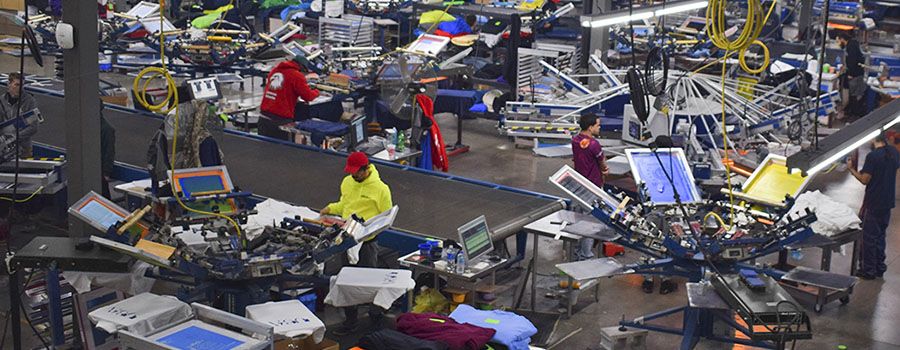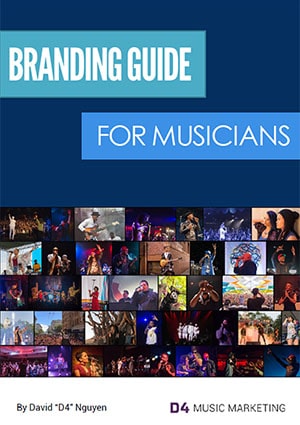
This is part 2 of 4 in my Merch for Musicians series.
It’s no surprise that one of the key components to making a living off music is selling merch. Not only is merch an income stream, it’s also a marketing / advertising tool to raise brand awareness.
At this point, you should have some designs on hand in the proper graphic file format. If you don’t have your designs yet, before sure to read this first.
You have merch designs ready to go. Now you need to find out what’s the best way to get it made, and into the hands of your fans. There are some factors to consider when getting merch made.
- How intricate is the design?
- What’s your budget?
- Where do you plan to sell it?
- Where are you keeping inventory?
- Who’s fulfilling the orders?
Garment Terminology
Before getting into bulk ordering or print on-demand, I think it’s important to briefly go over certain terminology that you should know when it comes to getting merch garments made.
Screen Printing
Chances are most of the tees you own were screen printed. Screen printing is the more popular and traditional technique of printing designs on garments because of its durability and bulk production speed. Depending on the machine used, some places can pump out a few hundred shirts an hour.
Not to get too technical, but I do want to go over how screen printing works because it’s important to understand the preparation process as it relates to its costs on your end.
To start, your design is burned with UV light onto a mesh screen that acts as a template or stencil. The mesh screen with your design is placed on the garment with ink covering the screen. A blade or squeegee is moved across the screen to essentially imprint the design onto the garment.
If your design contains more than one color, it will need to be separated into layers on a computer. Part of the setup process is having to create a screen for each color and figuring how to best layer them. Because of this, it can be time consuming with a lot of colors involved. Also, one color is printed at a time, so several screens are needed to produce a multi-colored design. This is why it will cost more to screen print more colors.
Depending on what equipment a print shop has, the maximum colors is usually 12, but you obviously don’t want to do more than 3 – 4. It’s very important to have the number of colors to be used in mind when designing merch.
Screen printing is best for cotton based garments. It’s harder to get detailed designs since resolution is 72 DPI, which is where digital printing comes in.
Direct-to-Garment / Digital Printing
Direct-to-Garment (DTG) is a print method where you directly print on a garment from the computer with a print machine. It is the newer technology when it comes to printing on garments.
One of the advantages of DTG is it allows you to print in full color without the extra cost normally associated with screen printing. This technique stands out for complex designs with a lot of colors or printing photo images. It’s better at capturing a photographic feel because it can print at a higher resolution than something like screen printing.
DTG is ideal for cotton garments or mostly cotton blends. You can still do it with polyester, but it may be a more tedious process, and results may not be optimal.
Because there’s less set up and prep involved, DTG allows you to create multiple samples and products quickly and efficiently. Depending on the machine, it can only print 10 – 20 full size designs an hour. It’s strength is in doing smaller quantities and one offs.
Sublimation Printing
Sublimation printing is a method for transferring high quality images to a garment without resolution loss.The way it works is you print a design on special sublimation paper and press it on the garment with a heat press. The heat causes the sublimation ink to transfer to the garment by turning from solid to a gas that embeds itself into the fabric and solidifies in its fibers.
Unlike a screen print, there’s no layer added on top of the garment. Sublimation basically infuses the design into the fabric, so the design is permanently dyed. This makes it very durable against washing, where it won’t peel or fade.
In order for sublimation ink to stick to the garment, the design needs to be pressed on polyester fabric. For best results, the garment needs to be made of at least 50% polyester. Also, it must be printed on light colored garments only.
This is a good method for printing all over design tees.
Embroidery
Embroidery is a technique to apply designs onto a garment through the use of a needle by stitching thread onto the fabric. For creating merch, this is typically done through the use of an embroidery machine. You typically see this on hats, beanies or sweatshirts to give the design dimension or a raised look.
Generally, you want to keep colors limited and designs simple if you want to use embroidery, as you are dealing with thread and stitches.
White Label / Private Label
Some places will give you the option to do white label, which is just adding your own custom inside labels to give the appearance that the garment is made under your own brand. Instead of leaving the neck tag of the blank t-shirt company your design was printed on, they will apply your label so the shirts don’t show the t-shirt company of the blanks.
This could be done with a woven sewn on label, or it could be printed on.
It’s not really necessary, but it helps to give your merch a more professional touch.
Bulk Ordering or Print On-Demand?
When it comes to ordering merch, there are two general approaches. They have their advantages and disadvantages, so it really depends on a number of different factors listed earlier.
Although this can apply to all types of merch, the main focus in this blog will be on clothing, especially for tees and hoodies. I’ll go over the two approaches to help you decide which is best for you if you’re a musician starting out.
Bulk Ordering with Screen Printing
Traditionally, you would order tees with your design in bulk from a screen print shop. You would then sell and manage the sales yourself, either at live shows or taking online orders. Here are the highlights of going this route.
- Longer Lasting Prints: In general, the type of ink used in screen printing lasts longer than digital printing. Generally, screen prints tend to hold up way better after multiple washes.
- Higher Upfront Costs / More Risk: Because you need to invest money upfront to get merch made, it carries more risk. These costs include setup fees and extra screens when dealing with multiple colors and layers. If you can’t sell all your merch, you end up eating the costs. You really have to do a good job of ordering the right sizes and quantities to match demand.
- Color Limits: Usually you want to stick to about 1 – 3 colors with screen printing because it gets pricier when you use a lot of colors. There’s more set up and work involved using multiple screens. Unlike digital printing or sublimation, there’s a limit of about 12 colors.
- Manage Your Own Inventory: Ordering bulk with screen printing means you have to store and manage your own inventory.
- Best for Bulk: Screen printing is ideal for volume, not just quality, and for lower cost per item. As discussed earlier, there can be a lot of setup fees involved so it’s best to do bulk to minimize those costs.
- Higher Minimums: In order to make screen printing worthwhile, there’s a minimum you are required to order. It can be as low as $50 to get price breaks. This is because there’s more work and set up involved with screen printing, especially if your design has a lot of colors. Designs with multiple colors involve a screen for each color, which costs more.
- Higher Profit Margins: Even though you’re paying more money up front, it ends up costing less to make each item when ordering in bulk. This means you take home more profit compared to using a drop shipper.
Drop Shipping with Print on Demand
Drop shipping is when you outsource the making and fulfillment of merch to another manufacturer, retailer or wholesaler. Orders you receive, typically through some online store front, are sent directly to the drop shipper so they can take care of the rest. You don’t carry any of the stock or have to manage any inventory.
This approach is often known as print on-demand or made to order due to the use of direct-to-garment (DTG) technology, which is basically the ability to use a computer to print the designs directly on the garment with minimal prep work and set up compared to screen printing. It’s also known as digital printing.
The drop shipping model is the more modern option as an all inclusive, print on-demand service that not only makes the merch, but also handles fulfillment and shipping.
The process is simple. You set up an online shop that sells your mech on your website. A fan buys a tee and the drop shipper gets the order. They make it and ship it to the fan, but the fan has no idea the merch is being created and fulfilled by another company. The drop shipper charges you a wholesale price that includes the cost of the item. You profit off the difference based on what you decide to charge. If the drop shipper charges you $15 to make and ship your branded tee to a fan and you charge $25 on your website, you make $10 for every shirt you sell.
Here are the highlights of using drop shipping:
- No Color Limits: Unlike screen printing, there’s no color limit. DTG allows you to print full color designs without any additional costs.
- No Upfront Costs / No Risk: You don’t need to invest any money upfront when using a DTG / print on-demand service. It’s free to set up and you’re only charged when orders are placed. Requires no money upfront so there’s no risk.
- More Convenient: Once you set up products with your design and add it to your store front, the only thing you need to do is market and drive sales. Everything after an order is placed is handled by the drop shipper.
- Less Profit Per Item: The cost or fees of the service are included in the price to make each tee, which means you would technically make less profit by selling each tee. However, it saves you a lot of time and work because you don’t need to fulfill the order yourself.
- No Minimum Order: Unlike screen printing, there’s no minimum you need to meet to place an order. Making one shirt costs the same as making ten. This makes it easy and cheap to make prototypes and samples to test designs.
- No Inventory: Since you don’t hold inventory, there’s no storage or stock concerns.
- More Merch Options and Variety: Drop shippers offer a wide range of different products you can make on-demand. This ranges from different garments, mugs, backpacks, posters, etc. Since you don’t need to buy bulk and commit to one item, it’s easier to sell different branded products.
- Not Good for Bulk Orders: The downside of DTG is that it’s not good at doing bulk. No matter how many you order, it’s the same cost per garment. No price breaks. It’s ideal for doing one offs or smaller orders.
Which approach is best?
It depends. In my opinion, you generally want to go with screen prints over direct-to-garment (digital printing) whenever possible. Although you do need to pay more upfront, you’re able to make more money in the long term.
Here’s a side-by-side look at screen printing versus digital printing:
To me, the biggest reason is because screen printing is much better in terms of print quality compared to DTG. When it comes to washability, DTG doesn’t hold up as well after multiple washes, especially if they’re not pre-treated or cured correctly. Sublimation is great for quality as well, but its use depends on the design and look you’re going for.
When your merch is a reflection of your brand, the last thing you want is the print on your shirt to crack or peel after a couple washes.
Ultimately it depends on your own situation, your design and the colors it contains. If you have an intricate design with a lot of colors or a photo design, chances are screen printing will not be feasible. Depending where you are in your career, it may make sense to start with DTG drop shipper. It’s also a good opportunity to test out designs before committing more money to ordering bulk.
Weigh Your Options and Shop Around
Before jumping right in, you want to do some research and find the right place for you. Shop around to get prices and figure out what’s the best option for your situation.
For drop shipping or DTG options, check out the 3 most popular services:
Please Note: The small commission I would receive if you conduct a sale using the affiliate link above plays absolutely no role in my recommendation for Printful or any other affiliate services. Read my statement on affiliate links for full disclosure.
Here are some suggestions for screen printing:
- Try checking around locally first, to see prices. Ask what’s the minimum order. Find out where the price breaks for high quantities. Number of colors for screen prints. Offer payment plans. Design costs.
- Ask other artists, business owners or brands where they get their merch made. Chances are they’ve had more experience and can recommend good places.
- Some places may do a warehouse option where you can order bulk screen printing to make it cheaper per unit. They can store the inventory and fulfill orders for you at a cost.
- Find out how much you would profit for each tee sold for each place. Calculate the total cost per tee. Be sure to factor in other costs and fees like shipping, taxes, screen charges, etc.
Other Tips
Keep It Simple – Start simple with one or two designs. You don’t want to offer many choices just yet.
Factor All Costs – To ensure that you’re going to be profitable, know all the costs involved to factor into price. Make sure to keep track of inventory, as well as how much you spent and sold.
Colors Matter – Be sure to think about colors before creating a design, especially for screen printing. You don’t want to end up with a design that costs too much to make or too complicated.
Quality First – Don’t compromise quality for lower prices. Get the highest quality you can. The quality of your merch is a reflection of your brand. You don’t want to disappoint anyone who buys merch that doesn’t last.
Order Smaller Batches – Although it may not be cheaper, it may be a better idea to order in smaller batches to test the waters first. You don’t want to sink too much money into merch and risk not selling it all.
Consider DIY (Do It Yourself) – Chances are you’re not going to have thousands of dollars laying around to invest in a sublimation or digital printing machine. However, you may be able to find a reasonably priced DIY screen printing kit to do some basic designs or find a creative way to add your branding to a blank item.
Something one of the artists I work with, AstraLogik, has done is get inexpensive blanks from overseas and adding their branding to it. It could be a patch you iron on, or something you sew on to give it some sort of branded touch.

In their case, they burned their logo on to a wood chip and sewed it on to colorful handbags and backpacks. The bags they got from the Philippines fit their branding aesthetic and it sold well for them.
This the end of part 2.
In the next blog in this series, I will dive into tips on how to sell more merch at shows.
D4’s Merch For Musicians Blog Series
– Part 1: What Merch Should Independent Artists Make That Fans Will Actually Buy
– Part 2: Bulk Ordering Or Print On-Demand? What’s The Best Way For Musicians To Order Merch
– Part 3: How Musicians Can Maximize Merch Sales At In Person Shows
– Part 4: How Musicians Can Maximize Merch Sales Online (Coming Soon)







